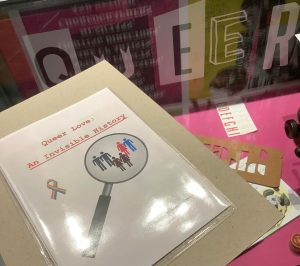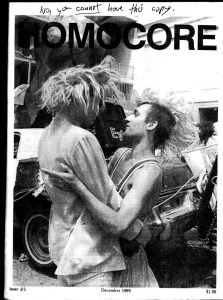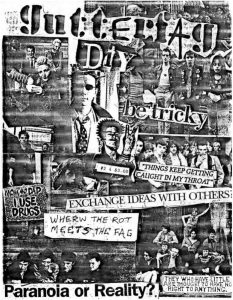Jamie Markham (BA History Student)
SEDIC (Humanities and Heritage: Students Equality, Diversity and Inclusion Committee) Student Representative
This past December, I was given the opportunity to create my own zine (available here on the Library website: Queer Love: An Invisible History) with the workshop that the lovely University of Lincoln staff hosted in the Library. Knowing little about zines, this event allowed me to unravel a rich queer history of self-expression. Much more than a booklet, the zine was a movement, an outlet, and a message to society. One in which allowed LGBTQ+ people to become fiercely visible in the face of oppression. Let me guide you through this rich cultural history as I take you back in time.

What is a Zine?
A Zine (pronounced ‘Zeen’) is a small circulation booklet. Produced usually with recycled materials, gluing, and reproduced via a copy machine. In the past, it was an act against the publishing industry, where queer people were forbidden from sharing their work. Not only queer people have been known to produce zines, but it was commonly used by minority groups who felt shunned by society. The Zine provided community for the individuals who felt the most rejected, this can include but is not subjected to; punks, LGBTQ+ and feminists. This form of art was used to share radical ideas, thoughts, and events amongst their communities and sent a strong message to others outside it. They shared the memo that they would still exist and thrive regardless of any backlash they received.
Queer Zines
A we now know, the zine was commonly known to be a method of connection, awareness and messaging within communities that were otherwise excluded from society. For this reason, zines have been particularly popular within the queer community. Generally, users of the zine were anti-capitalist or anti-establishment and usually right winged. Therefore, zines were loud, they sought attention, and the idea was to be unapologetic for their true identities.
It is impossible to fully understand the motive behind zines without endorsing ourselves within the history of the time. As Sara Century, co-founder of the Decoded Pride queer speculative fiction anthology quotes:
“Zines run the gamut in both quality and subject matter, but they all share a common and salient thread — they speak for their time, they are unedited, they are personal, and they deal with things you would never read about in major publications, from the personal to the political and beyond.” (Century, 2016)
I invite you therefore to take yourself to the 1980’s and 1990’s, where queer people were becoming restless, constantly fighting against homophobia and wanting to simply live freely. At the height, of the aids epidemic, when the US would not so much as address the crisis, zines were a way to spread resources, information and support to each other. This was a time when human rights for LGBTQ+ people were not recognised, using religion to justify the deaths of hundreds of thousands. In history, queer people have always found a way to find each other, to help each other and to freely express themselves. From molly houses, docks and street corners in the Victorian era to the drag balls of Harlem and Greenwich Village in the 1930’s, all the way through to the Stonewall Inn, 1969. The queer zine was so much more than sharing queer art, it was a movement, a protest, and a sense of belonging. The LGBTQ+ community to this very day, is a family, a home for the queer people who in history, who have been made to feel outcasted. It is so very important to preserve the movements of the past, which have paved the path for our rights today.
With this, I would like to share with you some examples of powerful self-published zines –
Homocore
One example of a historically acknowledged Zine was titled ‘Homocore’. We can assume its meaning is derived from ‘homo’ meaning homosexual and ‘core’ meaning the part of something that is central to its existence. Homocore was very popular amongst the LGBTQ+ community and focused on sharing many aspects of queer culture. In the zines, images of cross-dressing, gender non-confirmative clothing and homosexual nature were prominent. It was directed to the hardcore punk youth of the gay underground in America and popularised the queercore movement on the west coast. A defining moment in history, the queercore movement is a cultural or social movement that distinguished its discontent with society. The zine thus created an epidemic of magazines, music, writing and film that dealt with issues of sexual or gender identity.

The Daily Plague
Another example of a zine in which guided the queer community through times of pure desperation, is The Daily Plague (DTP). This was an Australian fanzine that provided support for queer people living with aids and how to live with it. Whilst other zines during this era focused on the science and political ideology (such as Diseased Pariah News and Infected Fa***t perspectives) this zine provided emotional solidarity and support to those affected. It is likely that this zine created a community for those who were living with the disease and it is known to be provide humour and humanity to the scene.
Gutterfag
This zine was created for the queer punk community in the 90’s by Jeff Junker in San Francisco. It is known to have featured many different aspects of the ‘outcasted’ in society. This included dark tales about being gay, disabled, depressed and even homeless, spreading awareness for how isolating it can be to appear different in society. This art was ever so important for ideas surrounding the ‘norm’ and how damaging it is to glorify perfection in the eyes of society.

Broomstick
Broomstick, a zine tailored towards queer women over forty, aimed to ‘sweep away’ the ‘cobwebs from our strength and unity’. It was an independent radical magazine that wrote from a feminist viewpoint on topics relating to older women and lesbians. It was collectively published between the years 1978 and 1993 in California. Founded by Maxine Spencer and Polly Taylor, its main goals were to confront ageism, the stereotypes of the disabled, and break down gender conventions in publishing. It specifically wished for older lesbian women to reveal their truths and urged these women to be their true queer selves regardless of the stereotypes.
In summary
These are just a few examples of this powerful movement for the queer community. More examples can be seen through searching the Queer Zine Archive online. Through this history of the zine movement, these works provided community and belonging when their rights to exist otherwise were denied. In times where there was seemingly no hope for queer people, zines allowed a conversation which encouraged activism and protest. Thus, demanding for the respect they so rightly deserve and with this an epidemic of self-expression begun.
So, this LGBTQ+ history month, I urge everybody, staff, and students, to take a look at the fabulous work of our University community. To remember the queer legacy of the zine and its rich history by heading to the ground floor of the main library, where zines inspired by queerness can be viewed.
References
Brouwer, D.C. (2005) Counterpublicity and corporeality in HIV/AIDS zines. Critical Studies in Media Communication, 22(5) 351-371. Available from https://proxy.library.lincoln.ac.uk/login?url=https://search.ebscohost.com/login.aspx?direct=true&db=ufh&AN=19426737&site=eds-live&scope=site [accessed 15 February 2023].
Century, S. (2016) ‘They bring activism to a new level’: a radical roundtable with female zinesters. The Establishment https://medium.com/the-establishment/the-power-of-zines-and-the-women-making-them-c8736bf0947d [accessed 15 February 2023].
LGBT Cultural Heritage (2023) Zines. LGBT Cultural Heritage. Available from https://www.lgbtculturalheritage.com/zines [accessed 15 February 2023]
The Queer Zine Archive (2014) QZAP zine archive. QZAP: The Queer Zine Archive Project. Available from https://archive.qzap.org [accessed 15 February 2023]
The Queer Zine Library (2023) Queer zine library. Available from https://www.queerzinelibrary.com [accessed 15 February 2023]